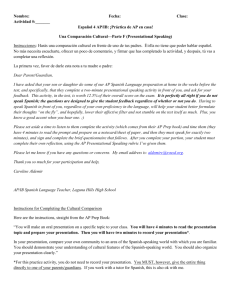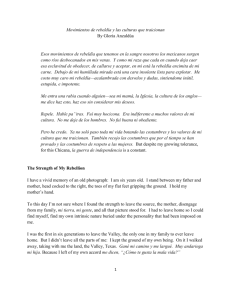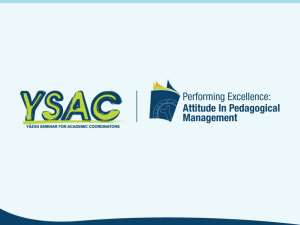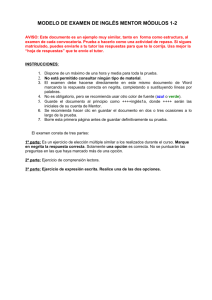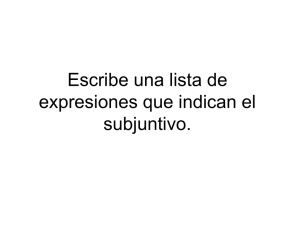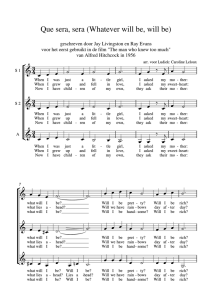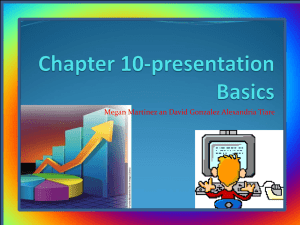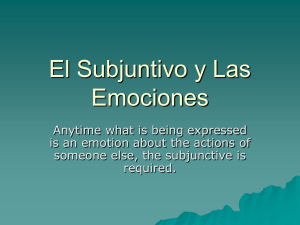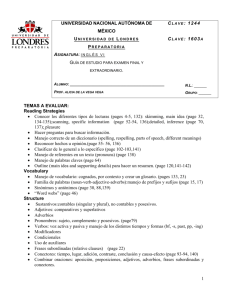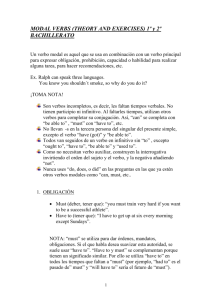1. Document setup: The full physical page size including all margins
advertisement
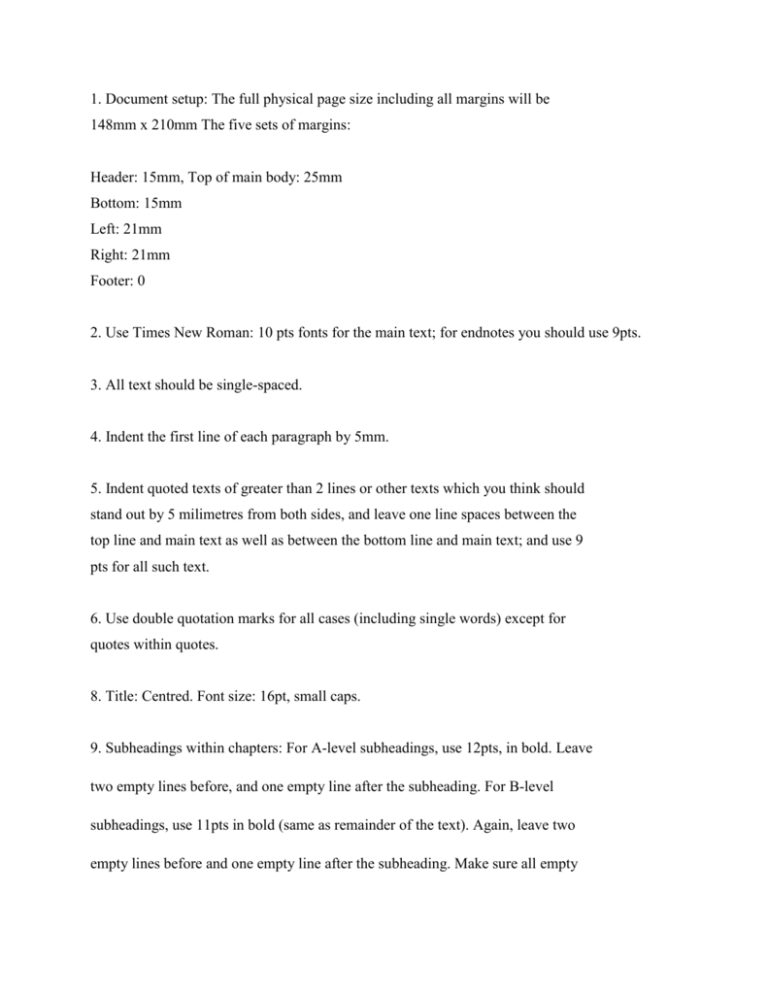
1. Document setup: The full physical page size including all margins will be 148mm x 210mm The five sets of margins: Header: 15mm, Top of main body: 25mm Bottom: 15mm Left: 21mm Right: 21mm Footer: 0 2. Use Times New Roman: 10 pts fonts for the main text; for endnotes you should use 9pts. 3. All text should be single-spaced. 4. Indent the first line of each paragraph by 5mm. 5. Indent quoted texts of greater than 2 lines or other texts which you think should stand out by 5 milimetres from both sides, and leave one line spaces between the top line and main text as well as between the bottom line and main text; and use 9 pts for all such text. 6. Use double quotation marks for all cases (including single words) except for quotes within quotes. 8. Title: Centred. Font size: 16pt, small caps. 9. Subheadings within chapters: For A-level subheadings, use 12pts, in bold. Leave two empty lines before, and one empty line after the subheading. For B-level subheadings, use 11pts in bold (same as remainder of the text). Again, leave two empty lines before and one empty line after the subheading. Make sure all empty lines are 10pt. Other Text Issues 1. To ensure that there are no extra spaces in the document, use your software's find and replace command to substitute all double spaces for single spaces. Repeat this procedure until no double spaces are found. 2. When using m-dashes, do not leave any spaces before or after the m-dash, e.g. trying to be—assuming it works—some kind of nobility... Also, do not use m-dashes with other sorts of dashes. 3. The referencing system you use should comply with the Chicago Manual of Style. 4. Number your pages with font size 9pts. For even pages place the number flush left, while for odd number pages, flush right (si no sabéis hacer esto, ya lo cambiaré yo). Use Arabic numerals. 5. Place a running header in the centre of every page. Even numbered pages should read ‘Chapter (Number spelled out)’ and odd numbered pages the title of the chapter. If the title is too long, use an abbreviated version (there are no hard and fast rules - use your judgement for how best to abbreviate it). Use 9pts for all headers, and capitalise. Note: in Word, the best way to position page numbers and running headers is by clicking on View, Header and Footer, and typing out the running header and centring it, and then using the control panel which appears for inserting the page number after double clicking on the left (in the case of even numbered pages) and right (in the case of odd numbered pages). (si no sabéis esto de los headers, dejadlo) 6. For all further text related issues, consult the Chicago Manual of Style. Images 1. It is recommended that you use TIFF files for producing images or photographs, and EPS files for vector graphics (illustrations). All images including photographs must be included in the main Word or other files submitted. 2. Take into account the size of CSP pages when including images. Your image will have to be resized if it is too large or too small, and this can prove problematic in certain cases. 3. Call your pictures or illustrations Fig. 4-3 or Ex. 2-3. The first number refers to the chapter number and the second to the illustration or image number within the chapter. (Solo poned el número de figura o ilustración, yo pondré el del capítulo). 4. Images should not be inserted into Word at more than 100% of their original size because this will cause a loss of quality. 5. Images for printing should always have at least a resolution of 300 dpi at the size in which they are going to be printed. 6. The size in which images are intended for printing and resolution (300 dpi) is the minimum required for the original scan or photograph: images cannot be recalculated to a larger size at the same resolution or else they will lose quality. 7. The quality of an image cannot be checked by looking at it on a screen (which often shows images at a resolution of 72 or 96 dpi in contrast to high quality print where they are usually printed at 360 dpi). 8. Color images for printing should always be saved in the CMYK mode (not in the RGB mode). Tables 1. It is recommended that you use some sort of background colour like light grey for the title row or column of a table, and ensure that the text of titles is in bold. This can be achieved by clicking on the relevant cells of your table, and then clicking on Table, Table Properties, Borders and Shading, and then selecting a colour (preferably 20%-grey). The result should be as below. 2. Do not use different types of formatting for different rows or columns unless you would like to differentiate between headings and body text. 3. Entitle your table in the same way that you entitled your image. E.g. Table 3-2 for the second table in chapter 3. Title1 Title2 Text Text Index With few exceptions all academic books should have some index. The ideal length of this index depends on the nature of the book, and the nature and number of entries very much depends on broad factors such as the subject area and genre of book (reference works vs. monographs) as well as individual factors such as the subject of the book. A further factor is of course the length of the book. Esto lo hago yo, pero necesito que me deis una lista de palabras. No voy a incluir los autores citados, a menos que los consideréis muy importantes. Otras cosas sobre esto: If you would like the word to appear as a subentry, decide the main entry under which this word ought to appear. E.g. the word ‘politics’ used in the context of France, may appear as a subentry under France. For all subentries under a main entry, the main entry must be spellt in exactly the same way. If it is not, Word will not recognise it as the same, and will include more than one main entry. In certain cases, it is preferable not to use the word in the form it appears in the text. For example, the subentry ‘politics’ under France might appear on a given page as ‘political’. In such cases, I (the editor) will insert in the Main Entry or Subentry slot, the word as you wish it to appear in the index. But I need to know the word you want to associate with that, so you need to tell me. Otras cosas: -Los artículos pueden estar en inglés o castellano, pero siempre en una de esas lenguas, es decir, que si hay citas en otras lenguas, pueden incluirse pero siempre con la traducción (vosotros decidís si en el texto principal va en el idioma original y en nota a pie traducido o al revés). -Se ruega enviar los artículos escritos en una lengua que se domine. -La bibliografía tiene que estar como se pide, el nombre del autor irá completo, etc. Revisad el ejemplo que os envío. -Si hay citas secundarias, es decir, que no habéis consultado sino que habéis tomado de otro autor, deberán ir completas en nota, y luego indicar la fuente con la página. -Si se toman citas o ideas de otros autores debe incluirse la página, no solo el año. -Para citas en artículos escritos en español se sigue la norma española de poner fuera el punto y dentro la nota, si la hay: según indica J. Pérez: “todo el cine de esa época es excepcional3”. Igualmente, después de dos puntos va minúscula. Normas españolas. -Para artículos en inglés, se sigue la norma inglesa, todo fuera de las comillas. -Las comillas se usan solo para las citas. Usamos las anglosajonas “ ”. Se usan las simples, si hay comillas dentro de comillas, por ejemplo, una cita dentro de una cita. -Cursiva. Se recomienda no abusar. Para neologismos, palabras en otros idiomas, segundos sentidos y títulos de libros, películas, periódicos… -Negrita dentro del texto. Usar poco; para datos importantes.
